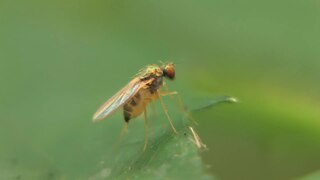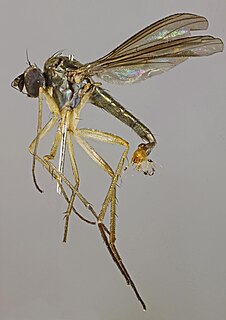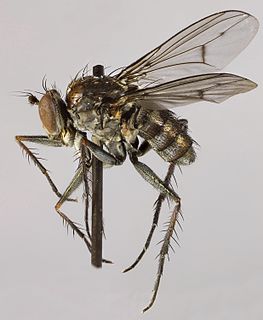
Dolichopodidae, the long-legged flies, are a large, cosmopolitan family of true flies with more than 7,000 described species in about 230 genera. The genus Dolichopus is the most speciose, with some 600 species.

Dolichopus is a large cosmopolitan genus of flies in the family Dolichopodidae. Adults are small flies, typically less than 8 mm in length. Nearly all species are metallic greenish-blue to greenish-bronze. It is the largest genus of Dolichopodidae with more than 600 species worldwide.

Hercostomus is a genus of flies in the family Dolichopodidae. It is a large genus, containing more than 483 species worldwide.
Calyxochaetus is a genus of flies in the family Dolichopodidae. It was formerly considered a subgenus of Sympycnus, but it is now considered a separate genus.

Chrysotimus is a genus of longlegged flies in the family Dolichopodidae. It is cosmopolitan in distribution, but it is probably paraphyletic with respect to several genera of limited distribution.

Chrysotus is a genus of flies in the family Dolichopodidae. It is one of the largest genera in the subfamily Diaphorinae, with more than 460 species. However, the genus is probably paraphyletic, and possibly even polyphyletic, with respect to several related genera such as Achradocera, Falbouria and Lyroneurus.
Nepalomyia is a genus of flies in the family Dolichopodidae.

Neurigona is a genus of flies in the family Dolichopodidae. It is a large genus, with over 150 known species.

Paraclius is a genus of flies in the family Dolichopodidae.
Pelastoneurus is a genus of flies in the family Dolichopodidae.

Sciapus is a genus of long-legged flies in the family Dolichopodidae. There are about 82 described species in Sciapus.

Sybistroma is a genus of flies in the family Dolichopodidae. It includes over 50 species, described mainly from the Palaearctic and Oriental realms. A single species is known from the Afrotropical realm. Until 2005, the genus was thought to be restricted to the Mediterranean in distribution, with five known species. It was recently expanded to include the former genera Hypophyllus, Ludovicius and Nordicornis, as well as some species of Hercostomus.

Tachytrechus is a genus of long-legged flies in the family Dolichopodidae.

Dolichopodinae is a subfamily of flies in the family Dolichopodidae.
Dolichopus longipennis is a species of long-legged fly in the family Dolichopodidae.
Medetera arnaudi is a species of long-legged fly in the family Dolichopodidae.
Dolichopus sincerus is a species of long-legged fly in the family Dolichopodidae.
Tachytrechus angustipennis is a species of long-legged fly in the family Dolichopodidae. Adults inhabit algal mats at Yellowstone National Park. The species is predatory, with their primary prey being Paracoenia eggs and larvae. Males are territorial.
Tachytrechus auratus is a species of long-legged fly in the family Dolichopodidae.









